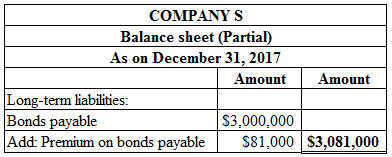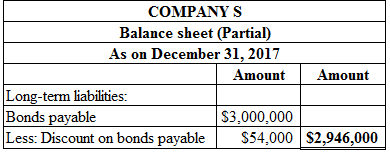
(a-1)
Bonds
Bonds are a kind of interest bearing notes payable, usually issued by companies, universities and governmental organizations. It is a debt instrument used for the purpose of raising fund of the corporations or governmental agencies. If selling price of the bond is equal to its face value, it is called as par on bond. If selling price of the bond is lesser than the face value, it is known as discount on bond. If selling price of the bond is greater than the face value, it is known as premium on bond.
Straight-line amortization bond
To Prepare: The
(a-1)
Explanation of Solution
Prepare the journal entry to record the issuance of bonds of Company S on January 1, 2017 as shown below:
| Date | Account title and Description | Debit | Credit |
| January 1, 2017 | Cash (1) | $3,090,000 | |
| Premium on bonds payable (2) | $90,000 | ||
| Bonds payable | $3,000,000 | ||
| (To record the issuance of bonds payable at premium value for Company S ) |
Table (1)
Working notes:
Calculate Cash received from issuance of bonds payable of Company S as shown below:
Calculate premium on bonds payable of Company S as shown below:
Description:
- Cash is a current asset, and increased. Therefore, debit cash account for $3,090,000.
- Premium on bonds payable is a contra liability, and increased. Therefore, credit premium on bonds payable for $90,000.
- Bonds payable is a long-term liability, and increased. Therefore, credit bonds payable account for $3,000,000.
(a-2)
To Prepare: The journal entry to record the issuance of bonds of Company S on January 1, 2017.
(a-2)
Explanation of Solution
Prepare the journal entry to record the issuance of bonds of Company S on January 1, 2017 as shown below:
| Date | Account title and Description | Debit | Credit |
| January 1, 2017 | Cash (1) | $2,940,000 | |
| Discount on bonds payable (2) | $60,000 | ||
| Bonds payable | $3,000,000 | ||
| (To record the issuance of bonds payable at discount value for Company S ) |
Table (2)
Working notes:
Calculate Cash received from issuance of bonds payable of Company S as shown below:
Calculate discount on bonds payable of Company S as shown below:
Description:
- Cash is a current asset, and increased. Therefore, debit cash account for $2,940,000.
- Discount on bonds payable is a contra liability, and decreased. Therefore, debit discount on bonds payable for $960,000.
- Bonds payable is a long-term liability, and increased. Therefore, credit bonds payable account for $3,000,000.
(b-1)
To Prepare: The premium on bond amortization table schedule for the first three payments of bonds payable.
(b-1)
Explanation of Solution
Prepare the premium on bond amortization table schedule for the first three payments of bonds payable as shown below:

Figure (1)
Description:
Interest to be paid is calculated by multiplying face
(b-2)
To Prepare: The discount on bond amortization table schedule for the first three payments of bonds payable.
(b-2)
Explanation of Solution
Prepare the discount on bond amortization table schedule for the first three payments of bonds payable as shown below:

Figure (2)
Description:
Interest to be paid is calculated by multiplying face value of bonds with stated interest rate. Interest expense to be recorded is calculated by deducting discount amortization bonds from interest to be paid. Discount amortization is calculated by dividing discount on bonds payable by number of years for discount. Unamortized discount is calculated by deducting current year discount amortization from previous year unamortized discount amount. Carrying value of bonds is calculated by taking the difference between face value of bonds and current year unamortized discount.
(c-1)
To Prepare: The journal entry to record the accrued interest expense and premium on amortize bond for Company S on December 31, 2017.
(c-1)
Explanation of Solution
Prepare the journal entry to record the accrued interest expense and premium on amortize bond for Company S on December 31, 2017 as shown below:
| Date | Account title and Description | Debit | Credit |
| December 31, 2017 | Interest expense | $231,000 | |
| Premium on bonds payable | $9,000 | ||
| Interest payable | $240,000 | ||
| (To record the accrued interest expense and premium on amortize bond for Company S) |
Table (3)
Description:
- Interest expense is a component of
stockholders’ equity , and decreased it. Therefore, debit interest expense account for $231,000. - Premium on bonds payable is a contra liability, and decreased. Therefore, debit premium on bonds payable for $9,000.
- Interest payable is a current liability, and increased. Therefore, credit interest payable account for $240,000.
(c-2)
To Prepare: The journal entry to record the accrued interest expense and discount on amortize bond for Company S on December 31, 2017.
(c-2)
Explanation of Solution
Prepare the journal entry to record the accrued interest expense and discount on amortize bond for Company S on December 31, 2017 as shown below:
| Date | Account title and Description | Debit | Credit |
| December 31, 2017 | Interest expense | $246,000 | |
| Discount on bonds payable | $6,000 | ||
| Interest payable | $240,000 | ||
| (To record the accrued interest expense and discount on amortize bond for Company S) |
Table (4)
Description:
- Interest expense is a component of stockholders’ equity, and decreased it. Therefore, debit interest expense account for $246,000.
- Discount on bonds payable is a contra liability, and increased. Therefore, credit discount on bonds payable for $6,000.
- Interest payable is a current liability, and increased. Therefore, credit interest payable account for $240,000.
(d-1)
To Prepare: The balance sheet presentation for issuance of bonds at December 31, 2017 using the selling price of $103.
(d-1)
Explanation of Solution
Prepare the balance sheet presentation for issuance of bonds at December 31, 2017 using the selling price of $103 as shown below:

Figure (3)
Description:
Premium on bonds payable for the year 2017 is $81,000 which is calculated by deducting from premium on amortize of bond for the year 2017 is $9,000 from premium on bonds payable on January 1, 2017 is $90,000.
(d-2)
To Prepare: The balance sheet presentation for issuance of bonds at December 31, 2017 using the selling price of $98.
(d-2)
Explanation of Solution
Prepare the balance sheet presentation for issuance of bonds at December 31, 2017 using the selling price of $98 as shown below:

Figure (4)
Description:
Discount on bonds payable for the year 2017 is $54,000 which is calculated by deducting from discount on amortize of bond for the year 2017 for $6,000, from discount on bonds payable, on January 1, 2017 for $60,000.
Want to see more full solutions like this?
Chapter 10 Solutions
FINANCIAL ACCT.:TOOLS...(LL)-W/ACCESS
- Aggies Inc. issued bonds with a $500,000 face value, 10% interest rate, and a 4-year term on July 1, 2018, and received $540,000. Interest is payable semi-annually. The premium is amortized using the straight-line method. Prepare journal entries for the following transactions. A. July 1, 2018: entry to record issuing the bonds B. Dec. 31, 2018: entry to record payment of interest to bondholders C. Dec. 31, 2018: entry to record amortization of premiumarrow_forwardSaverin, Inc. produces and sells outdoor equipment. On July 1, 2016, Saverin, Inc. issued 62,500,000 of 10-year, 9% bonds at a market (effective) interest rate of 8%, receiving cash of 66,747,178. Interest on the bonds is payable semiannually on December 31 and June 30. The fiscal year of the company is the calendar year. Instructions 1. Journalize the entry to record the amount of cash proceeds from the issuance of the bonds. 2. Journalize the entries to record the following: a. The first semiannual interest payment on December 31, 2016, and the amortization of the bond premium, using the interest method. (Round to the nearest dollar.) b. The interest payment on June 30, 2017, and the amortization of the bond premium, using the interest method. (Round to the nearest dollar.) 3. Determine the total interest expense for 2016.arrow_forwardNaval Inc. issued $200,000 face value bonds at a discount and received $190,000. At the end of 2018, the balance in the Discount on Bonds Payable account is $5,000. This years balance sheet will show a net liability of ________. A. $200,000 B. $180,000 C. $195,000 D. $205,000arrow_forward
- On January 1, 2018, Wawatosa Inc. issued 5-year bonds with a face value of $200,000 and a stated interest rate of 12% payable semi-annually on July 1 and January 1. The bonds were sold to yield 10%. Assuming the bonds were sold at 107.732, what is the selling price of the bonds? Were they issued at a discount or a premium?arrow_forwardVolunteer Inc. issued bonds with a $500,000 face value, 10% interest rate, and a 4-year term on July 1, 2018 and received $540,000. Interest is payable annually. The premium is amortized using the straightline method. Prepare journal entries for the following transactions. A. July 1, 2018: entry to record issuing the bonds B. June 30, 2019: entry to record payment of interest to bondholders C. June 30, 2019: entry to record amortization of premium D. June 30, 2020: entry to record payment of interest to bondholders E. June 30, 2020: entry to record amortization of premiumarrow_forwardEdward Inc. issued bonds with a $500,000 face value, 10% interest rate, and a 4-year term on July 1, 2018 and received $480,000. Interest is payable semiannually. The discount is amortized using the straight-line method. Prepare journal entries for the following transactions. A. July 1, 2018: entry to record issuing the bonds B. Dec. 31, 2018: entry to record payment of interest to bondholders C. Dec. 31, 2018: entry to record amortization of discountarrow_forward
- Whirlie Inc. issued $300,000 face value, 10% paid annually, 10-year bonds for $319,251 when the market of interest was 9%. The company uses the effective-interest method of amortization. At the end of the year, the company will record ________. A. a credit to cash for $28,733 B. a debit to interest expense for $31,267 C. a debit to Discount on Bonds Payable for $1,267 D. a debit to Premium on Bonds Payable for $1.267arrow_forwardDixon Inc. issued bonds with a $500,000 face value, 10% interest rate, and a 4-year term on July 1, 2018 and received $480,000. Interest is payable annually. The discount is amortized using the straight-line method. Prepare journal entries for the following transactions. A. July 1, 2018: entry to record issuing the bonds B. June 30, 2019: entry to record payment of interest to bondholders C. June 30, 2019: entry to record amortization of discount D. June 30, 2020: entry to record payment of interest to bondholders E. June 30, 2020: entry to record amortization of discountarrow_forward
- Principles of Accounting Volume 1AccountingISBN:9781947172685Author:OpenStaxPublisher:OpenStax College
 Financial AccountingAccountingISBN:9781305088436Author:Carl Warren, Jim Reeve, Jonathan DuchacPublisher:Cengage Learning
Financial AccountingAccountingISBN:9781305088436Author:Carl Warren, Jim Reeve, Jonathan DuchacPublisher:Cengage Learning Cornerstones of Financial AccountingAccountingISBN:9781337690881Author:Jay Rich, Jeff JonesPublisher:Cengage Learning
Cornerstones of Financial AccountingAccountingISBN:9781337690881Author:Jay Rich, Jeff JonesPublisher:Cengage Learning  Intermediate Accounting: Reporting And AnalysisAccountingISBN:9781337788281Author:James M. Wahlen, Jefferson P. Jones, Donald PagachPublisher:Cengage Learning
Intermediate Accounting: Reporting And AnalysisAccountingISBN:9781337788281Author:James M. Wahlen, Jefferson P. Jones, Donald PagachPublisher:Cengage Learning



